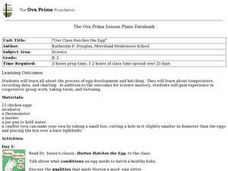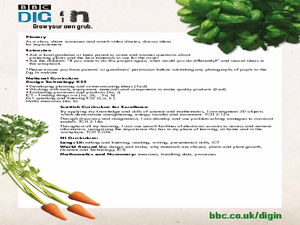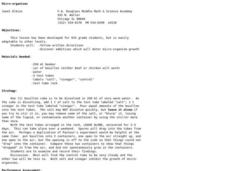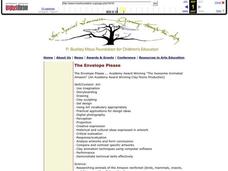Curated OER
The Day an Egg Solved the Mystery of the Cell
Students conduct an experiment comparing human cells to chicken cells. In this cells lesson plan, students conduct an experiment to see how nutrition moves through cells and how to better take care of their bodies.
Curated OER
What is an Organism?
Sixth graders take a pre-test and summarize teacher's discussion of cells, tissues, organs in their notebooks. They read selections on organisms in their textbook and perform a dissection of a chicken drumstick with the thigh attached....
Curated OER
What Is an Egg Without its Shell?
Students observe osmosis, a cellular process that normally can't be observed without a microscope, and use scientific method to observe osmosis in a chicken egg.
Curated OER
EGG-STRA, EGG-STRA LEARN ALL ABOUT IT
Young scholars explore how animals produce young by watching age-appropriate videos on the subject. They watch as chicken eggs either hatch or not in an incubator.
Curated OER
"Our Class Hatches the Egg"
Learners research all about the process of egg development and hatching. They access about temperature, recording data, and charting. In addition to the outcomes for science mastery, students gain experience in cooperative group work,...
Curated OER
Farm Animals
First graders use this Web Quest to find out about 6 different farm animals. They explore what each animal eats and what food humans get from each animal. They study about are pigs, sheep, goats, horses, cows, and chickens.
Curated OER
Design Technology- Grow Your Own Grub
Students design a protective cover for outdoor plants. In this agricultural lesson, students use chicken wire, plastic sheeting, and empty bottles to construct a cover for lettuce leaves. Students take digital photos of their project.
Curated OER
Micro-organisms
Sixth graders explore the world of micro-organisms. In this science lesson plan, 6th graders discover additives which will deter micro-organism growth.
Curated OER
Brain POP - Dinosaur
In this earth science worksheet, students complete a sheet by filling-in each blank with the correct response. They identify various types of dinosaurs and what they ate. Students also identify their various characteristics.
Curated OER
The Name Game
In this science instructional activity, students select 24 of the dinosaur names from the list and write them in the spaces on the bingo card. They match each of the dinosaurs listed to their correct description.
Curated OER
Moving and Growing
Young scholars learn to understand the role of both skeletons and exoskeletons. In this lesson on exoskeletons, students locate and label bones on diagram of a human skeleton, and observe and discuss bones of chicken and fish. Young...
Curated OER
Activity Plan 2-3: Baby Animals
Students get to be creative in learning about baby animals. In this early childhood lesson plan, students develop fine motor, math, and science skills as they sing, read, and share about baby animals.
Curated OER
Viruses Quiz
In this science worksheet, students will test their knowledge of viruses. Students answer ten multiple choice questions pertaining to virus characteristics.
Curated OER
A Dinosaur Scavenger Hunt
Students explain what a fossil is, learn six dinosaurs and tell one characteristic about each, then describe verbally what a dinosaur might have looked like.
Curated OER
Egg Story Mini Book
In this egg mini book learning exercise, students will color, cut out and collate pages to make a simple, picture mini book about the life cycle of a chicken.
Curated OER
Life Cycle
For this science worksheet, 3rd graders will investigate the life cycle of butterflies, frogs and chickens who hatch from eggs by creating a wheel. Students cut and assemble this wheel with windows that can display the pictures of...
Curated OER
Enzyme Lab
High schoolers examine the effects of specific enzymes on samples of liver tissue, muscle tissue (chicken), apples, and potatoes.
Curated OER
Comparative Embryology
Students compare and contrast the embryonic development of human, chicken and fish embryos. They create a detailed outline of similarities and differences among the three embryos at various stages of development.
Curated OER
Make a Farm
After a class discussion about where their food comes from learners construct a farm from a print-out (embedded in the plan). They work in groups, and trace a food source from the beginning. For example, they discover how a farmer grows...
University of Colorado
The Jovian Basketball Hoop
A radio receives radio signals, converts them to an electrical signal, then converts this signal to a sound signal, and amplifies the sound so people can hear it. Class members use this information to create a short-wave radio antenna...
Curated OER
The Envelope Please
Students research an animal of the rainforest. They create a computerized claymation to present their research.
LABScI
Cell Diffusion and Permeability: The See-Thru Egg Lab
Create a model to study a microscopic phenomenon. The seventh of 12 lessons uses an egg (without its shell) to represent a cell membrane. Using different solutions, learners explore the concept of cell diffusion. They monitor...
Curated OER
Introduction to Adaptation
Tenth graders observe collections of specimens and discuss their answers to provided questions. They explore common ancestry, homology, analogy, adaptive radiation, and evolution, while formulating creative answers based on their...
Curated OER
Dinosaur Tracks and Critical Thinking
Get your young scientists excited about geology through the study of dinosaur tracks! They will use their power of observation to learn how tracks are made and use critical thinking strategies to suggest a scenario in which they were...

























